We equip the workplace of the programmer in the village
Recently, on Habré, there have been frequent publications on the topic of moving programmers to various places - from Silicon Valley to the Russian hinterland.
I once made a choice - a village not far from the city, and in my life and professional activity I had to install the workplace of the programmer in the villages twice, install completely, including creating normal conditions for life.
If details are interesting: electrician / Internet / heating / water supply from scratch - I ask under kat (litter, many photos).
I chose this solution: an apartment in the city and a house in the village in the vicinity.
The disadvantages of this solution, in addition to the cost of the second property:
- no romance deaf village
- transportation costs: one way or another, anyway, from time to time you will wander into the city.
')
Advantages:
- near you all the infrastructure of the city: providers, medicine, education, supermarkets, etc.
- with everything around you - nature, silence, fresh air, a starry sky, which you will not see in the city, and silence, which simply does not happen in the city
- you have two places, and in the case of, for example, a sudden trawl, you can always retire and enter the stream in conditions of an almost absolute absence of distracting factors.
Of course, because of the specifics, the first thing I want to talk about is the network infrastructure: the Internet, network transport to the second workplace in the city, etc. But I will begin with a question that is much more important.
If you buy a house / cottage for work, ask a few neighbors what happens to the electrician.
Real observed situations:
- in the holiday village electricity (for purposes of not very clear savings) is turned off for the cold season, which can be from October to April
For the sake of fairness, I must say that in recent years this has almost never been observed, electricity is available in country houses all year round, and the reason is simple: wires without voltage are constantly being stolen in winter.
- the whole village (residential, not country) is powered by a very low-power measuring transformer, the load of more than a few hundred watts simply does not turn on.
But this, of course, is extreme in electricity supply. In reality, in the village, expect a power failure for several hours several times a month, but you need to take into account that anything can happen.
In both villages, an accident at the local transformer was observed: the infrastructure — a transformer, cables — is usually very old and has long been exhausted. Elimination of the consequences in both cases took several days, I had to leave to work in the city.
To combat temporary outages, forget about battery backup boxes. A computer on such a bespereboynik will stretch for several hours, but here's a different situation: the voltage disappeared in the evening, the child cries, do not turn on the water - the pump is electric, you don’t take the whole family to the city looking at night - all sorts of sensations in one word.
The output is a mini power plant, the price of the issue is from $ 200. It makes no sense to delve into the topic, but I will give one figure: the real consumption of gasoline is 0.5 liters per kilowatt * hour, and the diesel engine is slightly less.
IMHO - not the best choice: diesel fuel, let's say, smells, and nothing can be done about it. The gas station does not suffer from this.
There are some more nuances of the power station: it works loudly, it makes sense to put it somewhere in the barn, and, of course, you need to install additional automatic devices at the entrance to the house, which will allow you to temporarily disconnect the house from the common network and connect power to the station.
When choosing a station, consider the following: power is indicated not in kiloWatts (kW), but in kiloVoltAmperes (kVA). To get power in kilowatts (and this will be the maximum power you can consume), you need to multiply kVA by the power factor . For different appliances in different modes, the power factor can vary from 0.2 to 1. Feel free to take 0.6, that is, the power plant with a capacity of 2 kVA you can safely load on 1.2 kW.
The second nuance: inrush currents. All devices have them, but only electric motors can really create problems. Probably, the idea of vacuuming when powered from the station will not visit you, but you won’t get a refrigerator anywhere. Actually, take stock for starting currents of 20-30 percent of the total planned load.
If possible, connect three phases to the house.
Theoretical advantages: you can put all the powerful consumers in the house - the water tank, the pumps, the washing machine - on one phase, in this case the lighting will not flash when they are turned on.
Reality: in a village, the voltages at different phases can be very different. Here is what happened in my case:

As a result, the whole house was powered from the phase, which was 240 V.
Standard way: we look at the advertising of happy users and go to the nearest Intertelecom dealer (there is no other 3G coverage).
Nuance: when connecting to Intertelecom I was strongly pushed in a box - a modem + a WiFi-router, so called. Mi-Fi, like this:

Experiments with such a box gave the following:
- it is heated strongly
- do not turn on the external antenna, the signal just fell - we sit without connection
- the main thing: it works only from the battery . I do not really understand what the developers of this miracle device thought, but after an hour and a half of work, the battery sits down, and you need to turn off the device and take a break until it is fully charged (about an hour).
Of course, it is impossible to work this way, and as a result, a Pantech UMW-190 modem + antenna was purchased.

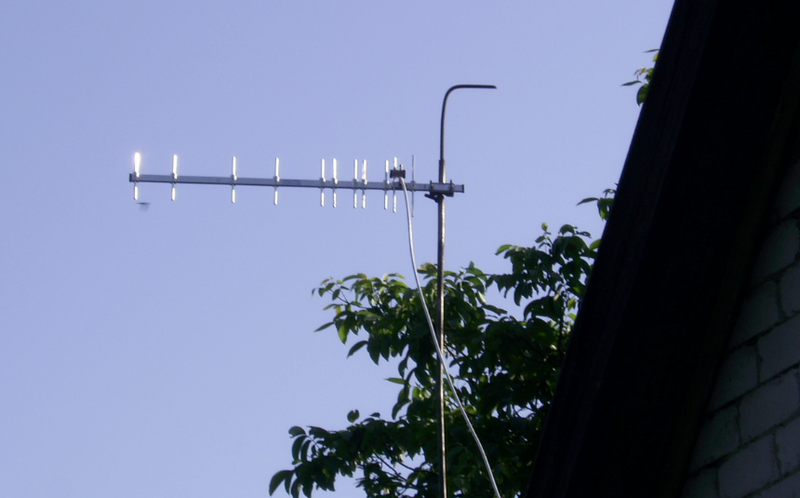
In Ukraine, there are definitely places where 3G Internet works well, for example, Intertelecom clearly gives 2.5-3 Mbit / s in Kremenchug with excellent communication quality without an external antenna.
Not always such happiness. In the villages of the Luhansk region, the maximum that could be squeezed out of Intertelecom was 300-400 kbps, and the technical support of this provider says that this is average over the network and no complaints are accepted.
The quality of communication is the same: constant breaks, a drop in speed to 50-100 kbps, and with such drops, online support immediately indicates a computer / modem /user idiocy .
Suddenly, the dignity of the modem became clear: you can insert a regular SIM card into it and switch to GPRS.
This saved the situation: the speed in the region of 250 kbps (MTS, Kyivstar), the connection is very stable - that is, a backup communication channel has been formed. The speed and quality of communication, by the way, allows you to listen to Internet radio.
But, of course, such a connection - both Intertelecom and GPRS - are good only for the very first time or as a reserve:
In theory, there is no problem to make a radio bridge and “reach out” the city provider’s network at home at a speed of several tens of megabits.
This is in theory. In practice it is required:
- direct visibility between points
- power supply, etc. at each point
- setting / diagnostics of points
- the correct orientation of the points at each other at a distance of several kilometers, focusing on very approximate points. At the same time, it is desirable to “get into” a very narrow sector, and the more precisely, the better - both speed and reliability of communication depend on it.
The terrain at such a distance looks like this:

Trouble, in a word, a lot. The main task, as it turned out, was to convince the provider to do it: a little money from one subscriber, a lot of trouble, plus a license for the frequency, etc.
So, in 2009, I still persuaded the provider.
It was impossible to even dream of direct visibility - that village was in a lowland. But not far on a high hill there was a gas station, a transit hub was located on it.
It turned out like this:
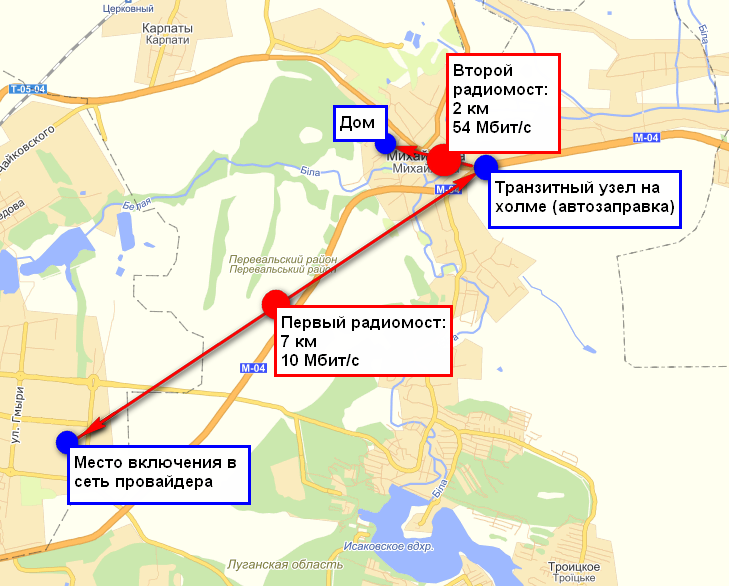
Equipment:
first radio bridge - some outdated Wi-Fi
second: NanoStation 5 (5 GHz).
Work on the creation of this whole farm took about a week. As a result, the radio bridge is still working steadily, the speed - 10 Mbps - is limited by the really outdated equipment of the long link.
It was a little easier with the terrain - the hills are by default. A point was found from which there is a direct visibility of the city - on high-rise buildings; within 3 days of the dense work of the installers of the provider, the radio bridge was launched.
Equipment: MikroTik RouterBoard SXT 5HnD access points, unnamed switch, box in the village, box at the provider, power (220 V) of the access point in the village - over a twisted pair.
In the city, the access point is located on a high-rise building and is included in the transport hub of the provider.
In the village, the access point and the box are mounted on power poles, the total length of the twisted pair from the access point to the house is 140 meters.
It looks like this:
Access point

Power and Switch Box
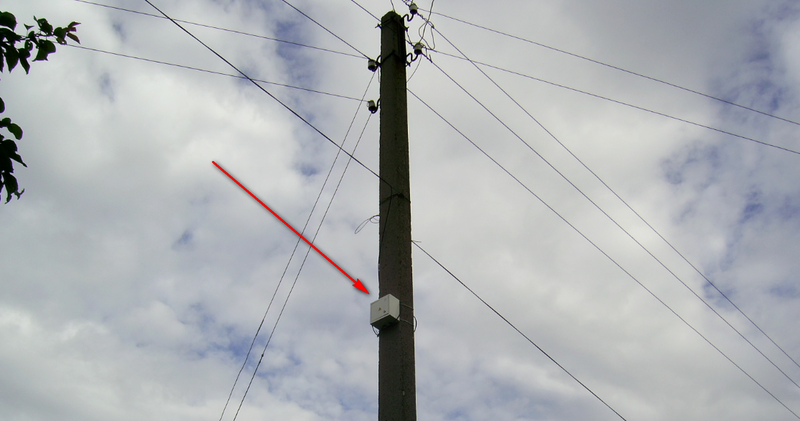
Position of the radio bridge on the map:

The first radio bridge, as it was said, works to this day. Successfully survived thunderstorms, frost at -35, rains, etc.
It was repaired only once: the NanoStation fastener buckle snapped, the access point leaned into a horizontal position (by the way, the link was, the speed just dropped). At this time, the rains began, the water began to flow through the connectors and the holes in the bottom (which was on top), the access point was filled with water, worked in this mode for three days (!) And failed.
The second radio bridge is open for several months, the Internet is fully-fledged in all its glory: an unlimited package of 36 Mbit / s, there is a claimed speed, torrents, TV and others online - like on the cable Internet in the city.
There is only one peculiarity: ping jumps - from 5 to 20 ms, it is the radio bridge that gives jumps, and I cannot say why. At work and generally using the Internet, this does not affect, although there are some nuances.
Lowering the map, I got a transport between the apartment in the city and the house in the village according to the scheme:
house <-> radio bridge <-> network Perevalsk <-> network of the city of Alchevsk <-> apartment.
The speed of the transport is limited by the radio bridge - all the same 40 Mbit / s, all that can be imagined - everything works, but there is a strangeness in the work of IPTV.
There is no UDP multicast broadcasting in the network, which includes a radio bridge, but in Alchevsk there is. I, without a doubt, installed the UdpToHttpProxy utility in the city, which converts the multicast to TCP, and tried to watch IPTV in the village. Shows, but clearly after a certain time begins to scary lag. It is enough to restart the same channel - lags stop, but after a certain time they start again. I did not find the explanation, in the city IPTV shows OK.
Assessing the number of people willing to have a normal Internet connection in the village, two city providers installed their equipment next to them:

Home is good. But I want to have comfort: water in the house, and I apologize - a shower and a toilet in the house.
There is no problem with water supply: a well / well, a pumping station or a submersible pump, simple automation - all this will be told to you right in the store.
There is a problem with the diversion of water. The very minimum that you have to take with the toilet and washing dishes is 50 liters per day, and with a shower - all 100-200 +.
Just dumping it in the garden / river is impossible for obvious reasons.
It is not clear for what reason, but the most popular solution I encountered was a pit lined with brick / cinder block with slots in the masonry. Well, it seems like everything that merges into this pit leaves, they say, gradually through these holes, and everything is fine.
It is not true. The water, of course, goes, everything else is not.
In the first house on the plot, the ground was beautiful, it absorbs well, nevertheless, similar structures of the drain from the neighbors were cleaned by hand every autumn with all the representations of this process. Sorry, but this is the reality of the village.
I did otherwise. Here is the design of the drain hole:
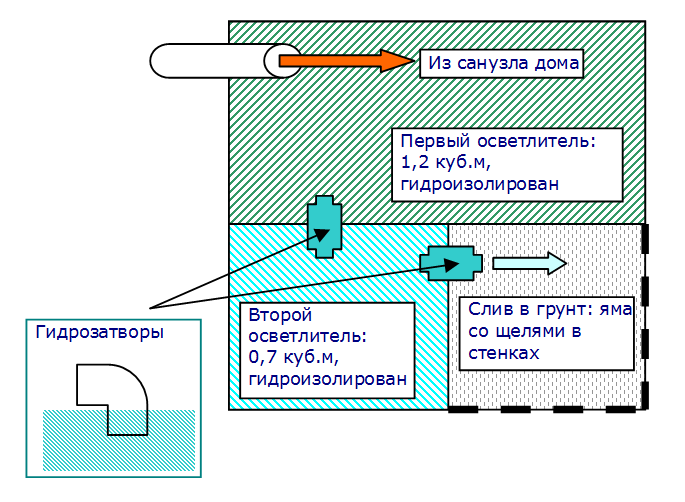
All, sorry, solid waste remains in the first clarifier, where biochemical processes are in full swing. For complete happiness, a bacterial preparation is added to the clarifier every six months ("Eparsil" or analogues). The second clarifier - for better cleaning, in fact the process water is already poured into the ground.
The diagram does not show hatches over each clarifier - for control.
There is no smell from this design. The whole system is at a depth of about a meter, covered with a lid and covered with earth at the same level as the site, roses grow from above.
It is also not necessary to clean the system and generally maintain it in any way. The system was made in 2007. Control in 2010 showed that there are silt deposits at a height of about 1.5-2 cm.
At this rate, the system, more precisely, the first clarifier, will fill up in about 20-30 years. According to reviews of people who cleaned it like this, yes, indeed, 20 years or more, and silt sediments are odorless and are excellent (and safe) fertilizer.
Anyway, a part of your pipes - both water and drain - will be cooled below zero in winter.
For drainage, this is uncritical in general, the drainage system is not afraid of frost (there will be a slight frost inside the pipe), but there is an important “but” - the discharge pipe must be even throughout its length. If there are bends on it due to the builders' oversight - such

then there will be water in the bends, in the winter it will freeze, then it will slowly freeze the flow from the house and quickly block the pipe (I almost stepped on this rake, thanks to those who watched it).
Theoretically, the drainage pipe should be instilled below the level of soil freezing (there are, by the way, maps of freezing). Practically there is no point in this - some sections of the pipe will still be in the freezing zone, and the pipe is not afraid of freezing - see above, this was checked in the winter several times.
Water supply in the winter is much more critical. Water under pressure is in the supply pipe and, of course, can freeze.
Experimentally: up to a temperature of -10 you can not worry too much if you use water at least once every few days. But below -10 you can be absolutely sure that the water in the pipe will freeze if you do not take any measures.
I once had a pipe frozen, it was -20 approximately. Experts promised to defrost very quickly, but in the end they spent about 10 hours on the whole team, including even such an extreme as the descent of a person into a deep well:
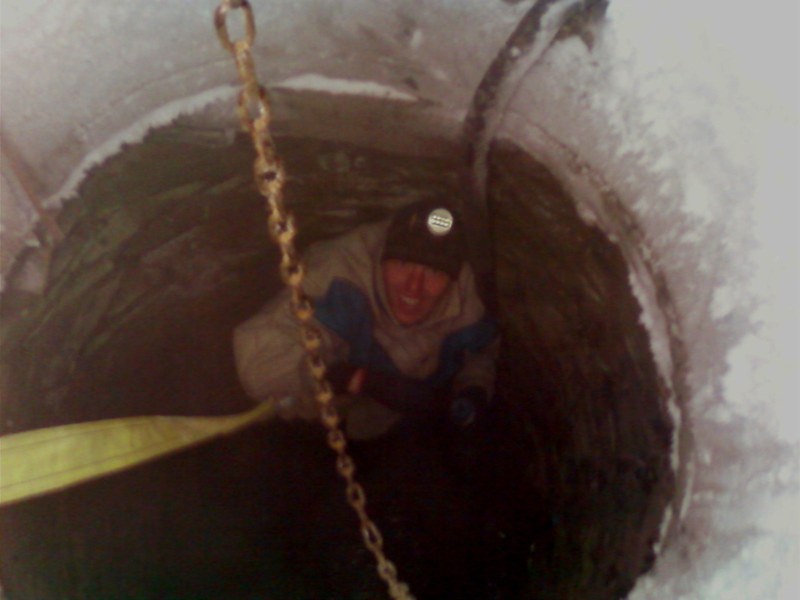
There are two ways to deal with this:
- constantly flush the water, that is, a small stream should flow all the time. The method is guaranteed, but you need to monitor the situation - the crane may, for example, be clogged with hardness salts or rust (there was such)
- make heating pipes: there are special cables that heat up.
But if you still have the system frozen and defrost it failed - you were left without water in the house until spring.
According to the existing standards, with a temperature difference of 40 degrees (+20 in the room, -20 outside) the thermal power of 1 kW per 10 square meters is required. m square premises.
This figure can be taken as a basis, but everything is much more complicated, it requires at least a rough calculation taking into account the material of the walls, etc.
If there is gas in the village, there are almost no questions.
In my first house, gas was delivered to the village in early 2008.
There was a choice: a boiler with automatics or gas convectors. I chose convectors for the following reasons:
- there is no power from 220V, respectively, no emergency situations in case of power failure or its jumps
- no need to pull water throughout the house, with the risk that the system will freeze if the boiler goes out
- the main thing: the gas is not burning in the house . The design of the convector is such that both the combustion chamber and its exhaust pipe go out into the street, and, according to the gas-workers, there have been cases of boilers exploding - good, heaped, with protection and automation - there have been, convectors - no.

The operation of convectors for four years has shown their advantages: it gets a little colder - we turn on the convectors, while you can not be afraid of leaving for even a month and return to a warm house.
There are 3 convectors installed in the house: two of 2 kW each and one for 5 kW (that is, only 9 kW of thermal power per 70 sq. M. Of the house).
Gas consumption in winter (-25): about 300 cu. meters per month, the area of the house - 70 square meters, the temperature in the house - +24. Convectors are turned on for about 1/2 -1/3 of the time (they have thermal automatics).
But such a low consumption is largely due to the material of the walls: the old house, the walls of the so-called "shingles" - a wooden frame filled with a mixture of clay and straw. I could not find the coefficient of thermal conductivity of such material, but I assume that it is at the level of porous materials, about 0.05 W / m * K.
Such a house does not require insulation, moreover, it is strongly not recommended to cover it with anything, etc. - the material that “breathes” is shingled, if closed, it can start to rot.
There is no gas in the holiday village, so there are two options: a coal / wood stove or electric heating.
I didn’t want to bother with coal, I chose electric heating.
Recently, a lot of talk about infrared heating - heat panels emit something there, heat everything around and everything is good. I bought two pieces for a sample of 0.7 kW each with regulators, after installation it looks like this:

The first conclusions: yes, such plates heat better than anything of the same capacity. It is warm, but their economy is a myth, they consume electricity from the heart. In a small house, count on 1000 kWh per month.
Remark: such heating in Ukraine will be golden if you use it not in the country - recently Ukraine adopted a law that if the consumption of an apartment / house exceeds 800 kWh per month, the price of 1 kWh increases about three times . For country cooperatives in the law made an exception.
If you connect electric heating, you need a separate wiring for it. For calculations, take the maximum current density for copper of 5 amperes per square millimeter. For two parallel-connected batteries with a capacity of 0.7 kW each, you will need a wire cross-section:
Battery Current = 1400 Watts / 220 Volts = 6.4 Amps
6.4 Ampere / 5 Ampere per square meter mm = 1.3 sq. mm,
that is, the standard wire section of 1.5 square meters. mm you will be satisfied. I took with a margin - 2.5 sq. M. mm
At temperatures around zero overboard, the batteries are turned on all the time, the thermostat does not turn them off, and the house is not hot - up to +20, the two batteries clearly do not have enough power, although it should.
The question is very complicated - there are windows, doors, etc. in the house, but a rough calculation can be made based on the fact that the wall material is a cinder block, the thermal conductivity coefficient is 0.46 W / m * K, 9 (!) Times higher than shingles , wall thickness - 0.2 m.
Power loss = Temperature difference / Total thermal resistance
Omitting all the calculations, I will give the result immediately: after one square meter of the wall, a half-cinder block with a temperature difference of 20 degrees (+20 in the house, 0 outside) leaves 46 watts.
Through all the walls of a small house (6 * 6 meters, the perimeter is 24 meters, the height of the walls is 2.7 meters) it leaves 24 * 2.7 * 46 = 2980 W.
Three kilowatts, and it's not even in winter - at zero on the street! Of course, batteries with a total power of 1,400 watts are few, and with further lowering the temperature outside (autumn, however), the temperature in the house will also decrease, and living and working in the house will be extremely uncomfortable.
In fairness, we note that there are still sources of heat in the house: each adult - 130 watts on average, a stationary computer - another 150 watts roughly, 70 watts - an old TV. But there are also other sources of losses: windows, entrance door, ceiling, floor.
We estimate what gives the insulation of the house. Omitting all the calculations (they are standard), we get that a 5 cm thick layer of mineral wool will reduce heat loss through the walls to 12 watts per square meter, that is, four times, and in this case the rated power of the batteries is 1 kW per 10 square meters , or 3 kilowatts per house - will be sufficient for comfortable work at any time of the year.
By the way, a layer of the same wool 10 cm thick will reduce the power loss to 7 watts / sq. m - that is, seven times compared with bare cinder block.
Of course, in the village it is wonderful: quiet, calm, fresh air. Having created the above-described conditions for living and working, you can work very productively, while improving the quality of life.
Sometimes it pulls into the city - just remember the energy of civilization, look at the night lights, at people. A few days - and I want to go back.
How much does this home improvement cost in a village? Several thousand dollars depends on many factors, for example, whether there is water or a well needs to be drilled (it is bold from 1 ton and more), gas in the house or you need to pay for a connection to the gas pipeline (another thousand dollars with gas distribution), etc.
How long does it take? If you have finances, you can keep within one warm season - three to four months.
Is it worth it? My opinion is definitely yes.
You canbecome the lord of the seas to have a personal pond:
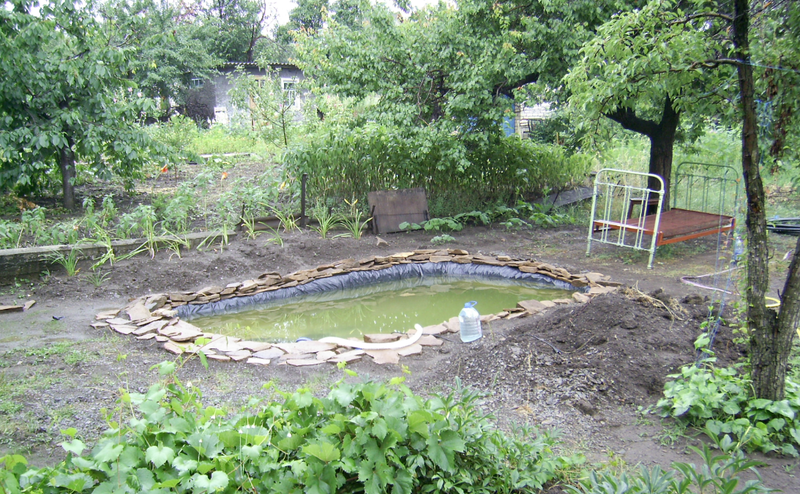
The open spaces evoke calm and peace:
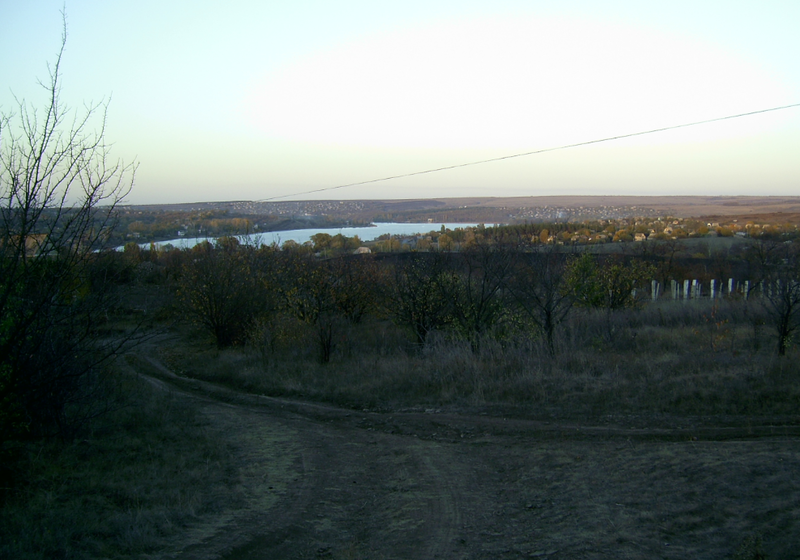
But most of all satisfied, of course, the youngest IT professionals:
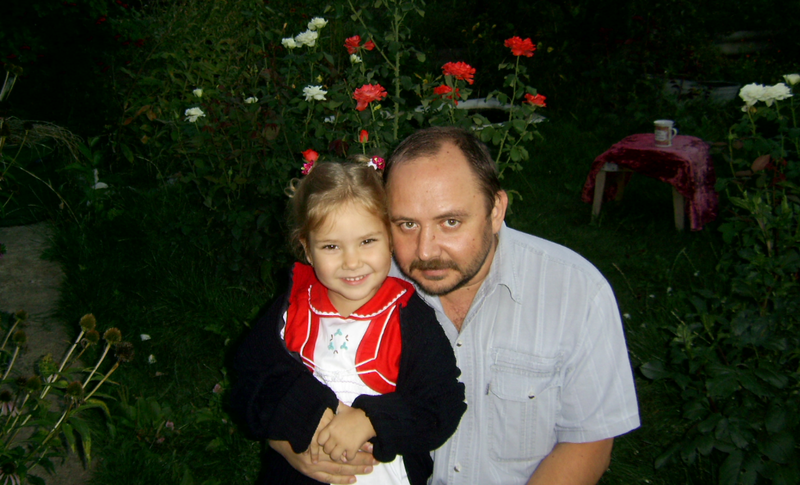
I once made a choice - a village not far from the city, and in my life and professional activity I had to install the workplace of the programmer in the villages twice, install completely, including creating normal conditions for life.
If details are interesting: electrician / Internet / heating / water supply from scratch - I ask under kat (litter, many photos).
The perfect solution is the opinion
I chose this solution: an apartment in the city and a house in the village in the vicinity.
The disadvantages of this solution, in addition to the cost of the second property:
- no romance deaf village
- transportation costs: one way or another, anyway, from time to time you will wander into the city.
')
Advantages:
- near you all the infrastructure of the city: providers, medicine, education, supermarkets, etc.
- with everything around you - nature, silence, fresh air, a starry sky, which you will not see in the city, and silence, which simply does not happen in the city
- you have two places, and in the case of, for example, a sudden trawl, you can always retire and enter the stream in conditions of an almost absolute absence of distracting factors.
We begin to settle
Of course, because of the specifics, the first thing I want to talk about is the network infrastructure: the Internet, network transport to the second workplace in the city, etc. But I will begin with a question that is much more important.
Power supply
If you buy a house / cottage for work, ask a few neighbors what happens to the electrician.
Real observed situations:
- in the holiday village electricity (for purposes of not very clear savings) is turned off for the cold season, which can be from October to April
For the sake of fairness, I must say that in recent years this has almost never been observed, electricity is available in country houses all year round, and the reason is simple: wires without voltage are constantly being stolen in winter.
- the whole village (residential, not country) is powered by a very low-power measuring transformer, the load of more than a few hundred watts simply does not turn on.
But this, of course, is extreme in electricity supply. In reality, in the village, expect a power failure for several hours several times a month, but you need to take into account that anything can happen.
In both villages, an accident at the local transformer was observed: the infrastructure — a transformer, cables — is usually very old and has long been exhausted. Elimination of the consequences in both cases took several days, I had to leave to work in the city.
To combat temporary outages, forget about battery backup boxes. A computer on such a bespereboynik will stretch for several hours, but here's a different situation: the voltage disappeared in the evening, the child cries, do not turn on the water - the pump is electric, you don’t take the whole family to the city looking at night - all sorts of sensations in one word.
The output is a mini power plant, the price of the issue is from $ 200. It makes no sense to delve into the topic, but I will give one figure: the real consumption of gasoline is 0.5 liters per kilowatt * hour, and the diesel engine is slightly less.
IMHO - not the best choice: diesel fuel, let's say, smells, and nothing can be done about it. The gas station does not suffer from this.
There are some more nuances of the power station: it works loudly, it makes sense to put it somewhere in the barn, and, of course, you need to install additional automatic devices at the entrance to the house, which will allow you to temporarily disconnect the house from the common network and connect power to the station.
An important electrotechnical nuance
When choosing a station, consider the following: power is indicated not in kiloWatts (kW), but in kiloVoltAmperes (kVA). To get power in kilowatts (and this will be the maximum power you can consume), you need to multiply kVA by the power factor . For different appliances in different modes, the power factor can vary from 0.2 to 1. Feel free to take 0.6, that is, the power plant with a capacity of 2 kVA you can safely load on 1.2 kW.
The second nuance: inrush currents. All devices have them, but only electric motors can really create problems. Probably, the idea of vacuuming when powered from the station will not visit you, but you won’t get a refrigerator anywhere. Actually, take stock for starting currents of 20-30 percent of the total planned load.
Three phases
If possible, connect three phases to the house.
Theoretical advantages: you can put all the powerful consumers in the house - the water tank, the pumps, the washing machine - on one phase, in this case the lighting will not flash when they are turned on.
Reality: in a village, the voltages at different phases can be very different. Here is what happened in my case:

As a result, the whole house was powered from the phase, which was 240 V.
Internet and network transport to the city
Mobile solutions
Standard way: we look at the advertising of happy users and go to the nearest Intertelecom dealer (there is no other 3G coverage).
Nuance: when connecting to Intertelecom I was strongly pushed in a box - a modem + a WiFi-router, so called. Mi-Fi, like this:

Experiments with such a box gave the following:
- it is heated strongly
- do not turn on the external antenna, the signal just fell - we sit without connection
- the main thing: it works only from the battery . I do not really understand what the developers of this miracle device thought, but after an hour and a half of work, the battery sits down, and you need to turn off the device and take a break until it is fully charged (about an hour).
Of course, it is impossible to work this way, and as a result, a Pantech UMW-190 modem + antenna was purchased.


In Ukraine, there are definitely places where 3G Internet works well, for example, Intertelecom clearly gives 2.5-3 Mbit / s in Kremenchug with excellent communication quality without an external antenna.
Not always such happiness. In the villages of the Luhansk region, the maximum that could be squeezed out of Intertelecom was 300-400 kbps, and the technical support of this provider says that this is average over the network and no complaints are accepted.
The quality of communication is the same: constant breaks, a drop in speed to 50-100 kbps, and with such drops, online support immediately indicates a computer / modem /
Suddenly, the dignity of the modem became clear: you can insert a regular SIM card into it and switch to GPRS.
This saved the situation: the speed in the region of 250 kbps (MTS, Kyivstar), the connection is very stable - that is, a backup communication channel has been formed. The speed and quality of communication, by the way, allows you to listen to Internet radio.
But, of course, such a connection - both Intertelecom and GPRS - are good only for the very first time or as a reserve:
Main communication channel
In theory, there is no problem to make a radio bridge and “reach out” the city provider’s network at home at a speed of several tens of megabits.
This is in theory. In practice it is required:
- direct visibility between points
- power supply, etc. at each point
- setting / diagnostics of points
- the correct orientation of the points at each other at a distance of several kilometers, focusing on very approximate points. At the same time, it is desirable to “get into” a very narrow sector, and the more precisely, the better - both speed and reliability of communication depend on it.
The terrain at such a distance looks like this:

Trouble, in a word, a lot. The main task, as it turned out, was to convince the provider to do it: a little money from one subscriber, a lot of trouble, plus a license for the frequency, etc.
First house, first radio bridge - details
So, in 2009, I still persuaded the provider.
It was impossible to even dream of direct visibility - that village was in a lowland. But not far on a high hill there was a gas station, a transit hub was located on it.
It turned out like this:

Equipment:
first radio bridge - some outdated Wi-Fi
second: NanoStation 5 (5 GHz).
Work on the creation of this whole farm took about a week. As a result, the radio bridge is still working steadily, the speed - 10 Mbps - is limited by the really outdated equipment of the long link.
The second house, the second radio bridge
It was a little easier with the terrain - the hills are by default. A point was found from which there is a direct visibility of the city - on high-rise buildings; within 3 days of the dense work of the installers of the provider, the radio bridge was launched.
Equipment: MikroTik RouterBoard SXT 5HnD access points, unnamed switch, box in the village, box at the provider, power (220 V) of the access point in the village - over a twisted pair.
In the city, the access point is located on a high-rise building and is included in the transport hub of the provider.
In the village, the access point and the box are mounted on power poles, the total length of the twisted pair from the access point to the house is 140 meters.
It looks like this:
Access point

Power and Switch Box

Position of the radio bridge on the map:

Reliability and operation of radio bridges
The first radio bridge, as it was said, works to this day. Successfully survived thunderstorms, frost at -35, rains, etc.
It was repaired only once: the NanoStation fastener buckle snapped, the access point leaned into a horizontal position (by the way, the link was, the speed just dropped). At this time, the rains began, the water began to flow through the connectors and the holes in the bottom (which was on top), the access point was filled with water, worked in this mode for three days (!) And failed.
The second radio bridge is open for several months, the Internet is fully-fledged in all its glory: an unlimited package of 36 Mbit / s, there is a claimed speed, torrents, TV and others online - like on the cable Internet in the city.
There is only one peculiarity: ping jumps - from 5 to 20 ms, it is the radio bridge that gives jumps, and I cannot say why. At work and generally using the Internet, this does not affect, although there are some nuances.
Shared network transport and the oddity in the work of IPTV via radio
Lowering the map, I got a transport between the apartment in the city and the house in the village according to the scheme:
house <-> radio bridge <-> network Perevalsk <-> network of the city of Alchevsk <-> apartment.
The speed of the transport is limited by the radio bridge - all the same 40 Mbit / s, all that can be imagined - everything works, but there is a strangeness in the work of IPTV.
There is no UDP multicast broadcasting in the network, which includes a radio bridge, but in Alchevsk there is. I, without a doubt, installed the UdpToHttpProxy utility in the city, which converts the multicast to TCP, and tried to watch IPTV in the village. Shows, but clearly after a certain time begins to scary lag. It is enough to restart the same channel - lags stop, but after a certain time they start again. I did not find the explanation, in the city IPTV shows OK.
Assessing the number of people willing to have a normal Internet connection in the village, two city providers installed their equipment next to them:

Water supply and its consequences
Home is good. But I want to have comfort: water in the house, and I apologize - a shower and a toilet in the house.
There is no problem with water supply: a well / well, a pumping station or a submersible pump, simple automation - all this will be told to you right in the store.
There is a problem with the diversion of water. The very minimum that you have to take with the toilet and washing dishes is 50 liters per day, and with a shower - all 100-200 +.
Just dumping it in the garden / river is impossible for obvious reasons.
It is not clear for what reason, but the most popular solution I encountered was a pit lined with brick / cinder block with slots in the masonry. Well, it seems like everything that merges into this pit leaves, they say, gradually through these holes, and everything is fine.
It is not true. The water, of course, goes, everything else is not.
In the first house on the plot, the ground was beautiful, it absorbs well, nevertheless, similar structures of the drain from the neighbors were cleaned by hand every autumn with all the representations of this process. Sorry, but this is the reality of the village.
I did otherwise. Here is the design of the drain hole:

All, sorry, solid waste remains in the first clarifier, where biochemical processes are in full swing. For complete happiness, a bacterial preparation is added to the clarifier every six months ("Eparsil" or analogues). The second clarifier - for better cleaning, in fact the process water is already poured into the ground.
The diagram does not show hatches over each clarifier - for control.
There is no smell from this design. The whole system is at a depth of about a meter, covered with a lid and covered with earth at the same level as the site, roses grow from above.
It is also not necessary to clean the system and generally maintain it in any way. The system was made in 2007. Control in 2010 showed that there are silt deposits at a height of about 1.5-2 cm.
At this rate, the system, more precisely, the first clarifier, will fill up in about 20-30 years. According to reviews of people who cleaned it like this, yes, indeed, 20 years or more, and silt sediments are odorless and are excellent (and safe) fertilizer.
Water supply and drainage in winter
Anyway, a part of your pipes - both water and drain - will be cooled below zero in winter.
For drainage, this is uncritical in general, the drainage system is not afraid of frost (there will be a slight frost inside the pipe), but there is an important “but” - the discharge pipe must be even throughout its length. If there are bends on it due to the builders' oversight - such

then there will be water in the bends, in the winter it will freeze, then it will slowly freeze the flow from the house and quickly block the pipe (I almost stepped on this rake, thanks to those who watched it).
Theoretically, the drainage pipe should be instilled below the level of soil freezing (there are, by the way, maps of freezing). Practically there is no point in this - some sections of the pipe will still be in the freezing zone, and the pipe is not afraid of freezing - see above, this was checked in the winter several times.
Water supply in the winter is much more critical. Water under pressure is in the supply pipe and, of course, can freeze.
Experimentally: up to a temperature of -10 you can not worry too much if you use water at least once every few days. But below -10 you can be absolutely sure that the water in the pipe will freeze if you do not take any measures.
I once had a pipe frozen, it was -20 approximately. Experts promised to defrost very quickly, but in the end they spent about 10 hours on the whole team, including even such an extreme as the descent of a person into a deep well:

There are two ways to deal with this:
- constantly flush the water, that is, a small stream should flow all the time. The method is guaranteed, but you need to monitor the situation - the crane may, for example, be clogged with hardness salts or rust (there was such)
- make heating pipes: there are special cables that heat up.
But if you still have the system frozen and defrost it failed - you were left without water in the house until spring.
Heating and heat insulation
Theory
According to the existing standards, with a temperature difference of 40 degrees (+20 in the room, -20 outside) the thermal power of 1 kW per 10 square meters is required. m square premises.
This figure can be taken as a basis, but everything is much more complicated, it requires at least a rough calculation taking into account the material of the walls, etc.
House number 1
If there is gas in the village, there are almost no questions.
In my first house, gas was delivered to the village in early 2008.
There was a choice: a boiler with automatics or gas convectors. I chose convectors for the following reasons:
- there is no power from 220V, respectively, no emergency situations in case of power failure or its jumps
- no need to pull water throughout the house, with the risk that the system will freeze if the boiler goes out
- the main thing: the gas is not burning in the house . The design of the convector is such that both the combustion chamber and its exhaust pipe go out into the street, and, according to the gas-workers, there have been cases of boilers exploding - good, heaped, with protection and automation - there have been, convectors - no.

The operation of convectors for four years has shown their advantages: it gets a little colder - we turn on the convectors, while you can not be afraid of leaving for even a month and return to a warm house.
There are 3 convectors installed in the house: two of 2 kW each and one for 5 kW (that is, only 9 kW of thermal power per 70 sq. M. Of the house).
Gas consumption in winter (-25): about 300 cu. meters per month, the area of the house - 70 square meters, the temperature in the house - +24. Convectors are turned on for about 1/2 -1/3 of the time (they have thermal automatics).
But such a low consumption is largely due to the material of the walls: the old house, the walls of the so-called "shingles" - a wooden frame filled with a mixture of clay and straw. I could not find the coefficient of thermal conductivity of such material, but I assume that it is at the level of porous materials, about 0.05 W / m * K.
Such a house does not require insulation, moreover, it is strongly not recommended to cover it with anything, etc. - the material that “breathes” is shingled, if closed, it can start to rot.
House 2: the myth of the economy of electric heating and an example of the calculation of thermal insulation
There is no gas in the holiday village, so there are two options: a coal / wood stove or electric heating.
I didn’t want to bother with coal, I chose electric heating.
Recently, a lot of talk about infrared heating - heat panels emit something there, heat everything around and everything is good. I bought two pieces for a sample of 0.7 kW each with regulators, after installation it looks like this:

The first conclusions: yes, such plates heat better than anything of the same capacity. It is warm, but their economy is a myth, they consume electricity from the heart. In a small house, count on 1000 kWh per month.
Remark: such heating in Ukraine will be golden if you use it not in the country - recently Ukraine adopted a law that if the consumption of an apartment / house exceeds 800 kWh per month, the price of 1 kWh increases about three times . For country cooperatives in the law made an exception.
Heating calculation
If you connect electric heating, you need a separate wiring for it. For calculations, take the maximum current density for copper of 5 amperes per square millimeter. For two parallel-connected batteries with a capacity of 0.7 kW each, you will need a wire cross-section:
Battery Current = 1400 Watts / 220 Volts = 6.4 Amps
6.4 Ampere / 5 Ampere per square meter mm = 1.3 sq. mm,
that is, the standard wire section of 1.5 square meters. mm you will be satisfied. I took with a margin - 2.5 sq. M. mm
At temperatures around zero overboard, the batteries are turned on all the time, the thermostat does not turn them off, and the house is not hot - up to +20, the two batteries clearly do not have enough power, although it should.
Heat loss calculation
The question is very complicated - there are windows, doors, etc. in the house, but a rough calculation can be made based on the fact that the wall material is a cinder block, the thermal conductivity coefficient is 0.46 W / m * K, 9 (!) Times higher than shingles , wall thickness - 0.2 m.
Power loss = Temperature difference / Total thermal resistance
Omitting all the calculations, I will give the result immediately: after one square meter of the wall, a half-cinder block with a temperature difference of 20 degrees (+20 in the house, 0 outside) leaves 46 watts.
Through all the walls of a small house (6 * 6 meters, the perimeter is 24 meters, the height of the walls is 2.7 meters) it leaves 24 * 2.7 * 46 = 2980 W.
Three kilowatts, and it's not even in winter - at zero on the street! Of course, batteries with a total power of 1,400 watts are few, and with further lowering the temperature outside (autumn, however), the temperature in the house will also decrease, and living and working in the house will be extremely uncomfortable.
In fairness, we note that there are still sources of heat in the house: each adult - 130 watts on average, a stationary computer - another 150 watts roughly, 70 watts - an old TV. But there are also other sources of losses: windows, entrance door, ceiling, floor.
We estimate what gives the insulation of the house. Omitting all the calculations (they are standard), we get that a 5 cm thick layer of mineral wool will reduce heat loss through the walls to 12 watts per square meter, that is, four times, and in this case the rated power of the batteries is 1 kW per 10 square meters , or 3 kilowatts per house - will be sufficient for comfortable work at any time of the year.
By the way, a layer of the same wool 10 cm thick will reduce the power loss to 7 watts / sq. m - that is, seven times compared with bare cinder block.
Summary and Final Considerations
Of course, in the village it is wonderful: quiet, calm, fresh air. Having created the above-described conditions for living and working, you can work very productively, while improving the quality of life.
Sometimes it pulls into the city - just remember the energy of civilization, look at the night lights, at people. A few days - and I want to go back.
How much does this home improvement cost in a village? Several thousand dollars depends on many factors, for example, whether there is water or a well needs to be drilled (it is bold from 1 ton and more), gas in the house or you need to pay for a connection to the gas pipeline (another thousand dollars with gas distribution), etc.
How long does it take? If you have finances, you can keep within one warm season - three to four months.
Is it worth it? My opinion is definitely yes.
You can

The open spaces evoke calm and peace:

But most of all satisfied, of course, the youngest IT professionals:

Source: https://habr.com/ru/post/155593/
All Articles